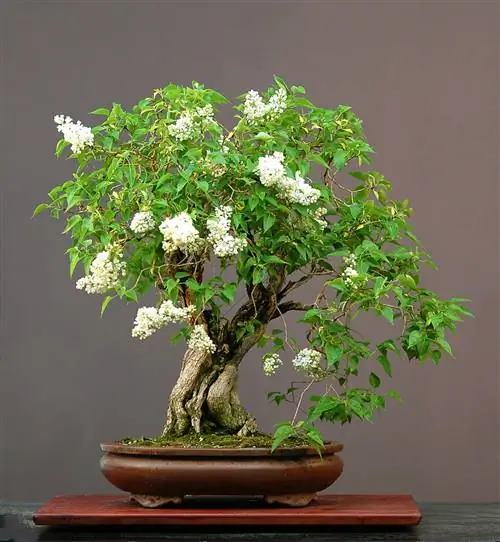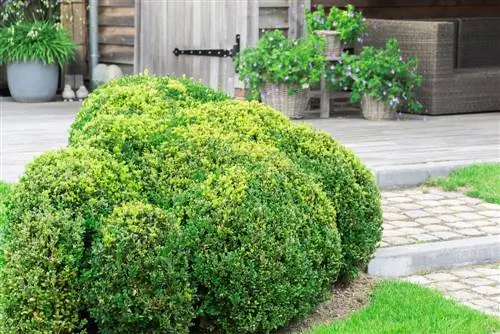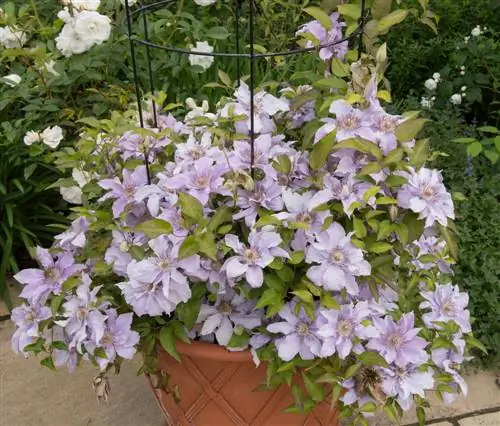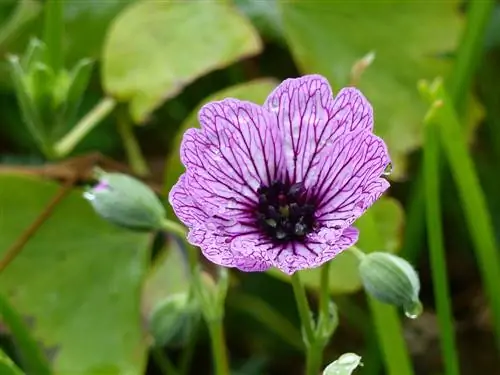- Author admin [email protected].
- Public 2023-12-16 16:46.
- Last modified 2025-01-23 11:21.
Lilac (Syringa) with its numerous species and varieties is one of the most popular ornamental trees in the garden. It is considered to be extremely easy to care for and impresses every year with its magnificent, intensely fragrant flowers. The beauty of the shrub or small tree is particularly effective when cultivated as a bonsai.

How to care for a lilac bonsai?
A lilac bonsai needs a lot of sun, airy and calcareous substrates, regular watering without waterlogging and a low-nitrogen fertilizer every two weeks. Cut back after flowering, wire if necessary and repot and root cut every two years. Hardy and can overwinter outside.
Which lilac is suitable as a bonsai?
Basically, you can train practically any lilac for bonsai, although some species and varieties are very vigorous and reach heights of between three and four meters. It is more practical to use lower lilacs, for example
- Dwarf lilac Syringa meyeri ‘Palibin’
- Korean dwarf lilac Syringa patula 'Miss Kim'
- Royal lilac Syringa chinensis ‘Saugeana’
These varieties only grow to around two meters high and are easier to prune.
Care for lilac bonsai properly
In order for your lilac bonsai to thrive and bloom beautifully, it needs the right nutrients, a suitable planter and should also be repotted every two years. Lilac also doesn't belong in the apartment, but rather outdoors - the plant tolerates wind very well and feels most comfortable in an airy, sunny spot.
Location and substrate
Lilac needs a lot of sun. It is best to place it in a sunny, warm and airy location where it does not run the risk of drowning in the rain. If the plant gets too little light, it will only produce a few flowers or even no flowers at all. The substrate should be permeable, moderately nutrient-rich and calcareous.
Watering and fertilizing
The lilac doesn't like being wet at all, but you should still fertilize it regularly. Do not let the bonsai dry out to avoid damaging the fine roots. Fertilize approximately every two weeks with a liquid fertilizer low in nitrogen (€18.00 on Amazon), although you should never fertilize the dry root ball. It is better to administer the fertilizer together with the irrigation water.
Cutting and wiring
It is best to cut lilacs after they have bloomed. You can remove dead shoots straight away. Cut new shoots back to one or two leaves. Until around mid-July, young shoots can be shaped by wiring, but older twigs and branches are too inelastic and break quickly.
Repotting
Repot the lilac in fresh substrate every two years, whereby you should also carry out a root cut.
Wintering
The hardy lilac can easily overwinter outside.
Tip
It becomes particularly interesting if you cut down an old lilac and form a bonsai out of it.






